Project Governance and International Project Management: A UNICEF Case
VerifiedAdded on 2023/06/10
|11
|2689
|471
Report
AI Summary
This report delves into project governance and international project management, focusing on the role of project governance, its components, and factors influencing the success and challenges of international projects. It examines these concepts in the context of UNICEF, particularly its "Education Cannot Wait" project, highlighting the importance of competent teams, comprehensive planning, open communication, and strategic approaches. The report also addresses common issues faced in international project management, such as poor planning, lack of understanding of project scope, cultural awareness, and communication skills, emphasizing the need for organizations to understand cultural diversity and establish clear goals. This document is available on Desklib, a platform offering a wide range of study resources and solved assignments for students.
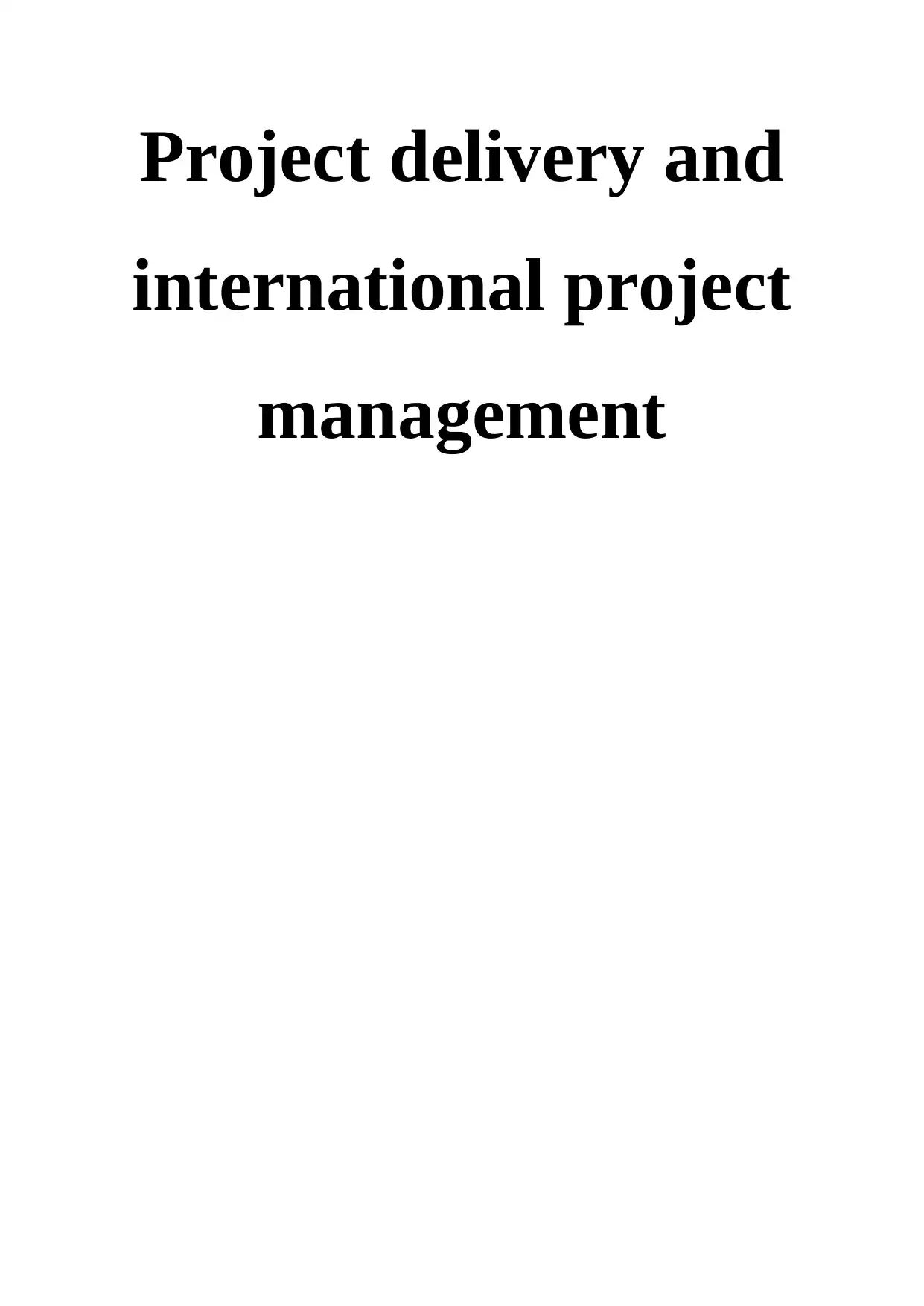
Project delivery and
international project
management
international project
management
Paraphrase This Document
Need a fresh take? Get an instant paraphrase of this document with our AI Paraphraser
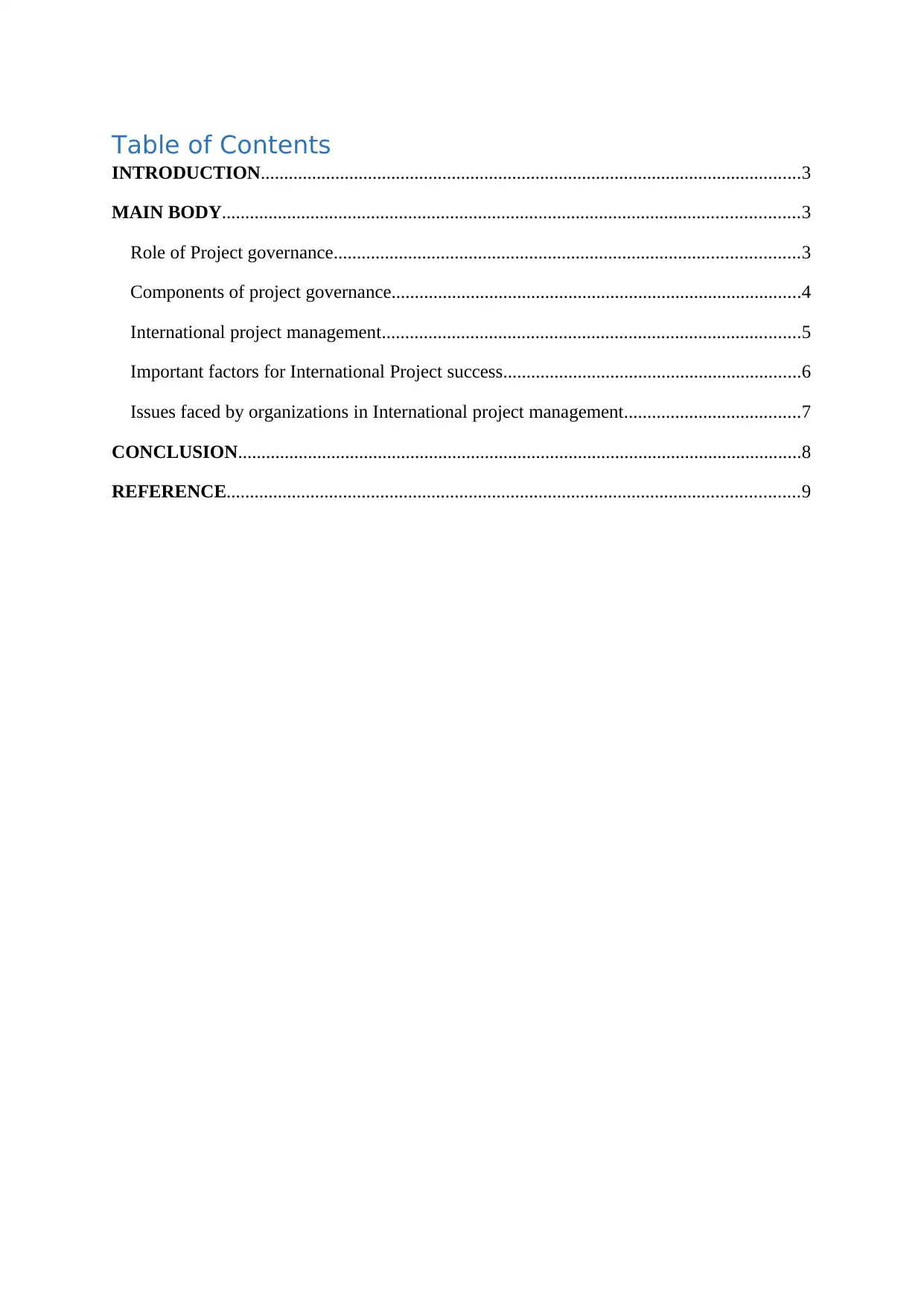
Table of Contents
INTRODUCTION....................................................................................................................3
MAIN BODY............................................................................................................................3
Role of Project governance....................................................................................................3
Components of project governance........................................................................................4
International project management..........................................................................................5
Important factors for International Project success................................................................6
Issues faced by organizations in International project management......................................7
CONCLUSION.........................................................................................................................8
REFERENCE...........................................................................................................................9
INTRODUCTION....................................................................................................................3
MAIN BODY............................................................................................................................3
Role of Project governance....................................................................................................3
Components of project governance........................................................................................4
International project management..........................................................................................5
Important factors for International Project success................................................................6
Issues faced by organizations in International project management......................................7
CONCLUSION.........................................................................................................................8
REFERENCE...........................................................................................................................9
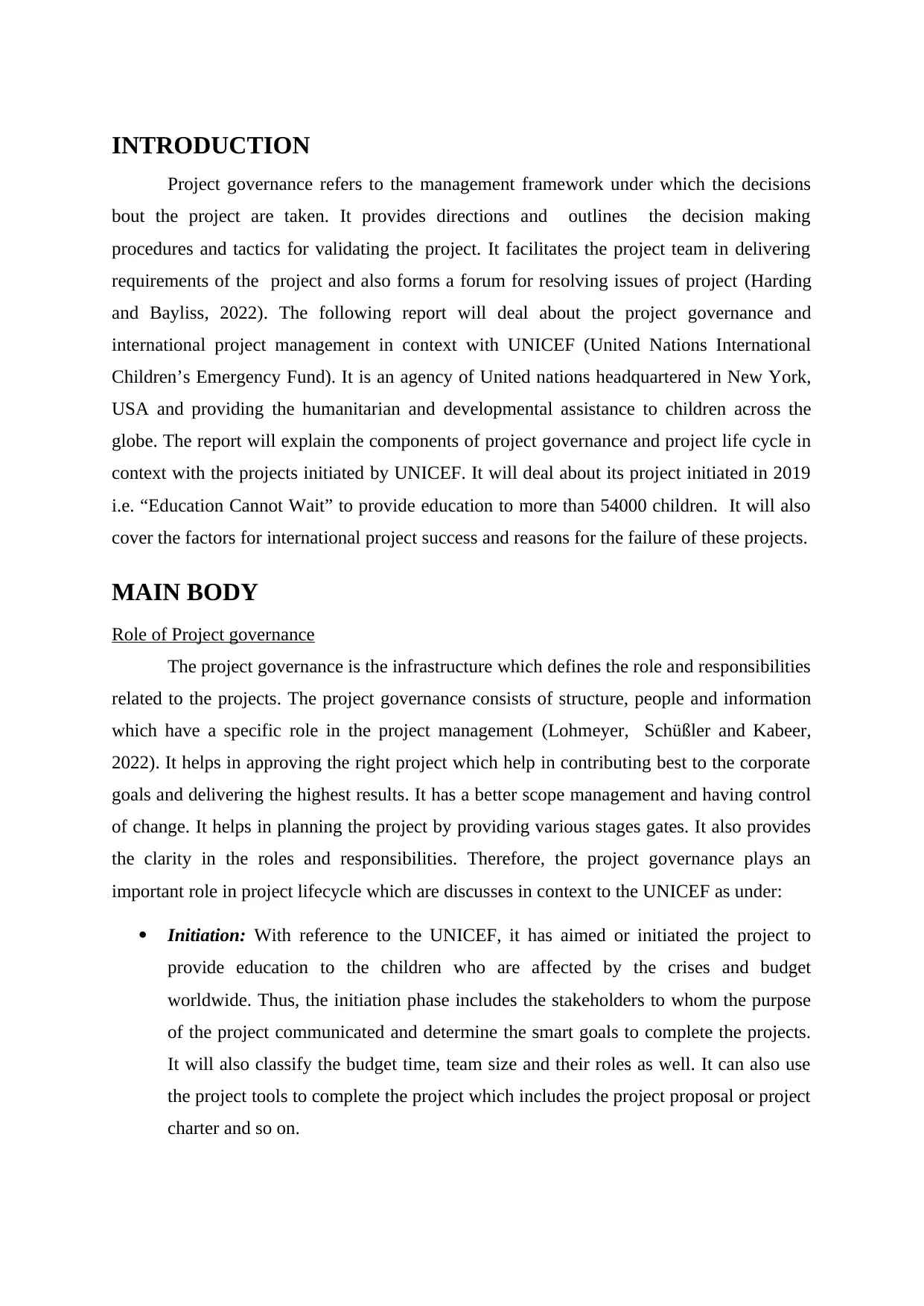
INTRODUCTION
Project governance refers to the management framework under which the decisions
bout the project are taken. It provides directions and outlines the decision making
procedures and tactics for validating the project. It facilitates the project team in delivering
requirements of the project and also forms a forum for resolving issues of project (Harding
and Bayliss, 2022). The following report will deal about the project governance and
international project management in context with UNICEF (United Nations International
Children’s Emergency Fund). It is an agency of United nations headquartered in New York,
USA and providing the humanitarian and developmental assistance to children across the
globe. The report will explain the components of project governance and project life cycle in
context with the projects initiated by UNICEF. It will deal about its project initiated in 2019
i.e. “Education Cannot Wait” to provide education to more than 54000 children. It will also
cover the factors for international project success and reasons for the failure of these projects.
MAIN BODY
Role of Project governance
The project governance is the infrastructure which defines the role and responsibilities
related to the projects. The project governance consists of structure, people and information
which have a specific role in the project management (Lohmeyer, Schüßler and Kabeer,
2022). It helps in approving the right project which help in contributing best to the corporate
goals and delivering the highest results. It has a better scope management and having control
of change. It helps in planning the project by providing various stages gates. It also provides
the clarity in the roles and responsibilities. Therefore, the project governance plays an
important role in project lifecycle which are discusses in context to the UNICEF as under:
Initiation: With reference to the UNICEF, it has aimed or initiated the project to
provide education to the children who are affected by the crises and budget
worldwide. Thus, the initiation phase includes the stakeholders to whom the purpose
of the project communicated and determine the smart goals to complete the projects.
It will also classify the budget time, team size and their roles as well. It can also use
the project tools to complete the project which includes the project proposal or project
charter and so on.
Project governance refers to the management framework under which the decisions
bout the project are taken. It provides directions and outlines the decision making
procedures and tactics for validating the project. It facilitates the project team in delivering
requirements of the project and also forms a forum for resolving issues of project (Harding
and Bayliss, 2022). The following report will deal about the project governance and
international project management in context with UNICEF (United Nations International
Children’s Emergency Fund). It is an agency of United nations headquartered in New York,
USA and providing the humanitarian and developmental assistance to children across the
globe. The report will explain the components of project governance and project life cycle in
context with the projects initiated by UNICEF. It will deal about its project initiated in 2019
i.e. “Education Cannot Wait” to provide education to more than 54000 children. It will also
cover the factors for international project success and reasons for the failure of these projects.
MAIN BODY
Role of Project governance
The project governance is the infrastructure which defines the role and responsibilities
related to the projects. The project governance consists of structure, people and information
which have a specific role in the project management (Lohmeyer, Schüßler and Kabeer,
2022). It helps in approving the right project which help in contributing best to the corporate
goals and delivering the highest results. It has a better scope management and having control
of change. It helps in planning the project by providing various stages gates. It also provides
the clarity in the roles and responsibilities. Therefore, the project governance plays an
important role in project lifecycle which are discusses in context to the UNICEF as under:
Initiation: With reference to the UNICEF, it has aimed or initiated the project to
provide education to the children who are affected by the crises and budget
worldwide. Thus, the initiation phase includes the stakeholders to whom the purpose
of the project communicated and determine the smart goals to complete the projects.
It will also classify the budget time, team size and their roles as well. It can also use
the project tools to complete the project which includes the project proposal or project
charter and so on.
⊘ This is a preview!⊘
Do you want full access?
Subscribe today to unlock all pages.

Trusted by 1+ million students worldwide
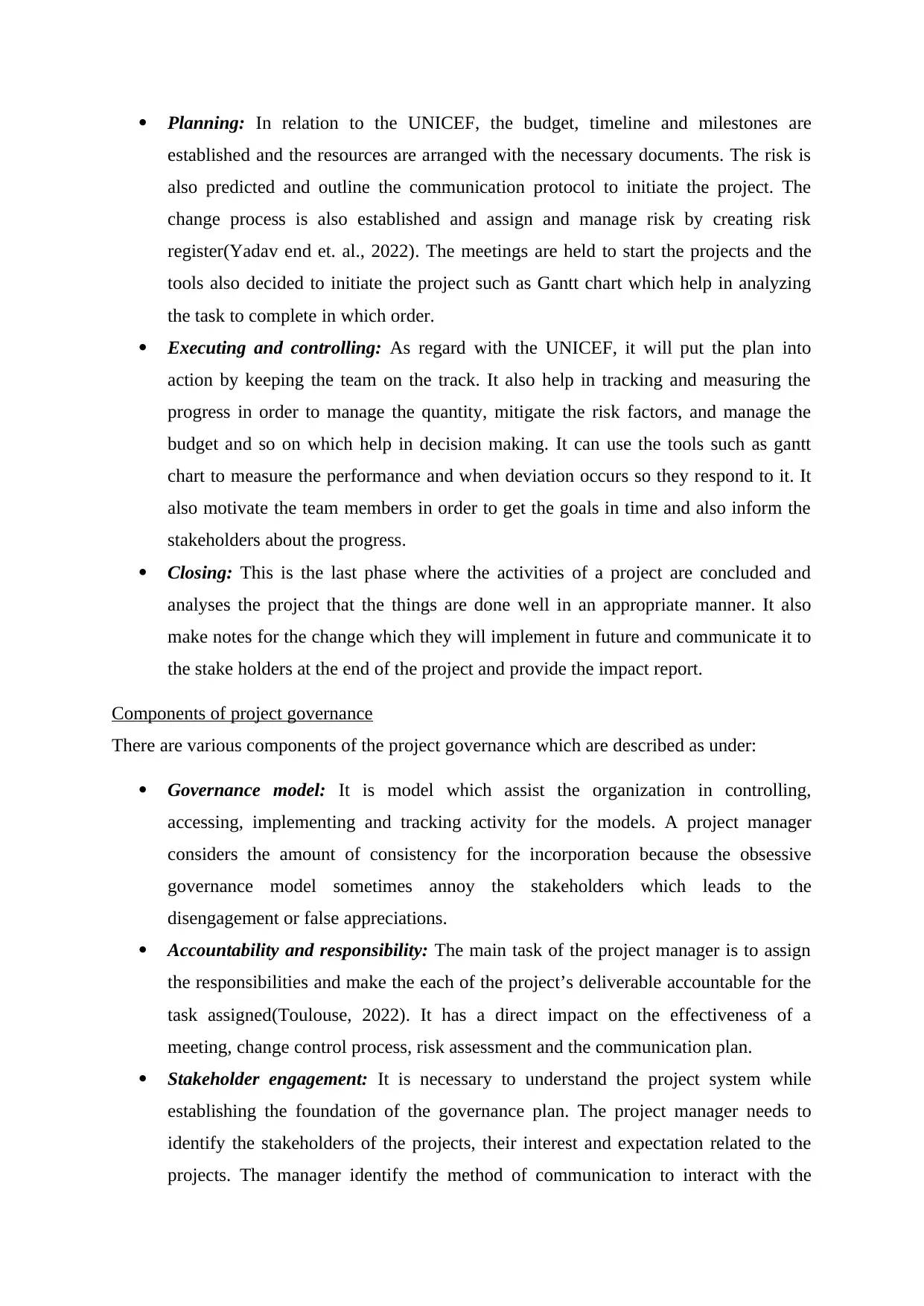
Planning: In relation to the UNICEF, the budget, timeline and milestones are
established and the resources are arranged with the necessary documents. The risk is
also predicted and outline the communication protocol to initiate the project. The
change process is also established and assign and manage risk by creating risk
register(Yadav end et. al., 2022). The meetings are held to start the projects and the
tools also decided to initiate the project such as Gantt chart which help in analyzing
the task to complete in which order.
Executing and controlling: As regard with the UNICEF, it will put the plan into
action by keeping the team on the track. It also help in tracking and measuring the
progress in order to manage the quantity, mitigate the risk factors, and manage the
budget and so on which help in decision making. It can use the tools such as gantt
chart to measure the performance and when deviation occurs so they respond to it. It
also motivate the team members in order to get the goals in time and also inform the
stakeholders about the progress.
Closing: This is the last phase where the activities of a project are concluded and
analyses the project that the things are done well in an appropriate manner. It also
make notes for the change which they will implement in future and communicate it to
the stake holders at the end of the project and provide the impact report.
Components of project governance
There are various components of the project governance which are described as under:
Governance model: It is model which assist the organization in controlling,
accessing, implementing and tracking activity for the models. A project manager
considers the amount of consistency for the incorporation because the obsessive
governance model sometimes annoy the stakeholders which leads to the
disengagement or false appreciations.
Accountability and responsibility: The main task of the project manager is to assign
the responsibilities and make the each of the project’s deliverable accountable for the
task assigned(Toulouse, 2022). It has a direct impact on the effectiveness of a
meeting, change control process, risk assessment and the communication plan.
Stakeholder engagement: It is necessary to understand the project system while
establishing the foundation of the governance plan. The project manager needs to
identify the stakeholders of the projects, their interest and expectation related to the
projects. The manager identify the method of communication to interact with the
established and the resources are arranged with the necessary documents. The risk is
also predicted and outline the communication protocol to initiate the project. The
change process is also established and assign and manage risk by creating risk
register(Yadav end et. al., 2022). The meetings are held to start the projects and the
tools also decided to initiate the project such as Gantt chart which help in analyzing
the task to complete in which order.
Executing and controlling: As regard with the UNICEF, it will put the plan into
action by keeping the team on the track. It also help in tracking and measuring the
progress in order to manage the quantity, mitigate the risk factors, and manage the
budget and so on which help in decision making. It can use the tools such as gantt
chart to measure the performance and when deviation occurs so they respond to it. It
also motivate the team members in order to get the goals in time and also inform the
stakeholders about the progress.
Closing: This is the last phase where the activities of a project are concluded and
analyses the project that the things are done well in an appropriate manner. It also
make notes for the change which they will implement in future and communicate it to
the stake holders at the end of the project and provide the impact report.
Components of project governance
There are various components of the project governance which are described as under:
Governance model: It is model which assist the organization in controlling,
accessing, implementing and tracking activity for the models. A project manager
considers the amount of consistency for the incorporation because the obsessive
governance model sometimes annoy the stakeholders which leads to the
disengagement or false appreciations.
Accountability and responsibility: The main task of the project manager is to assign
the responsibilities and make the each of the project’s deliverable accountable for the
task assigned(Toulouse, 2022). It has a direct impact on the effectiveness of a
meeting, change control process, risk assessment and the communication plan.
Stakeholder engagement: It is necessary to understand the project system while
establishing the foundation of the governance plan. The project manager needs to
identify the stakeholders of the projects, their interest and expectation related to the
projects. The manager identify the method of communication to interact with the
Paraphrase This Document
Need a fresh take? Get an instant paraphrase of this document with our AI Paraphraser
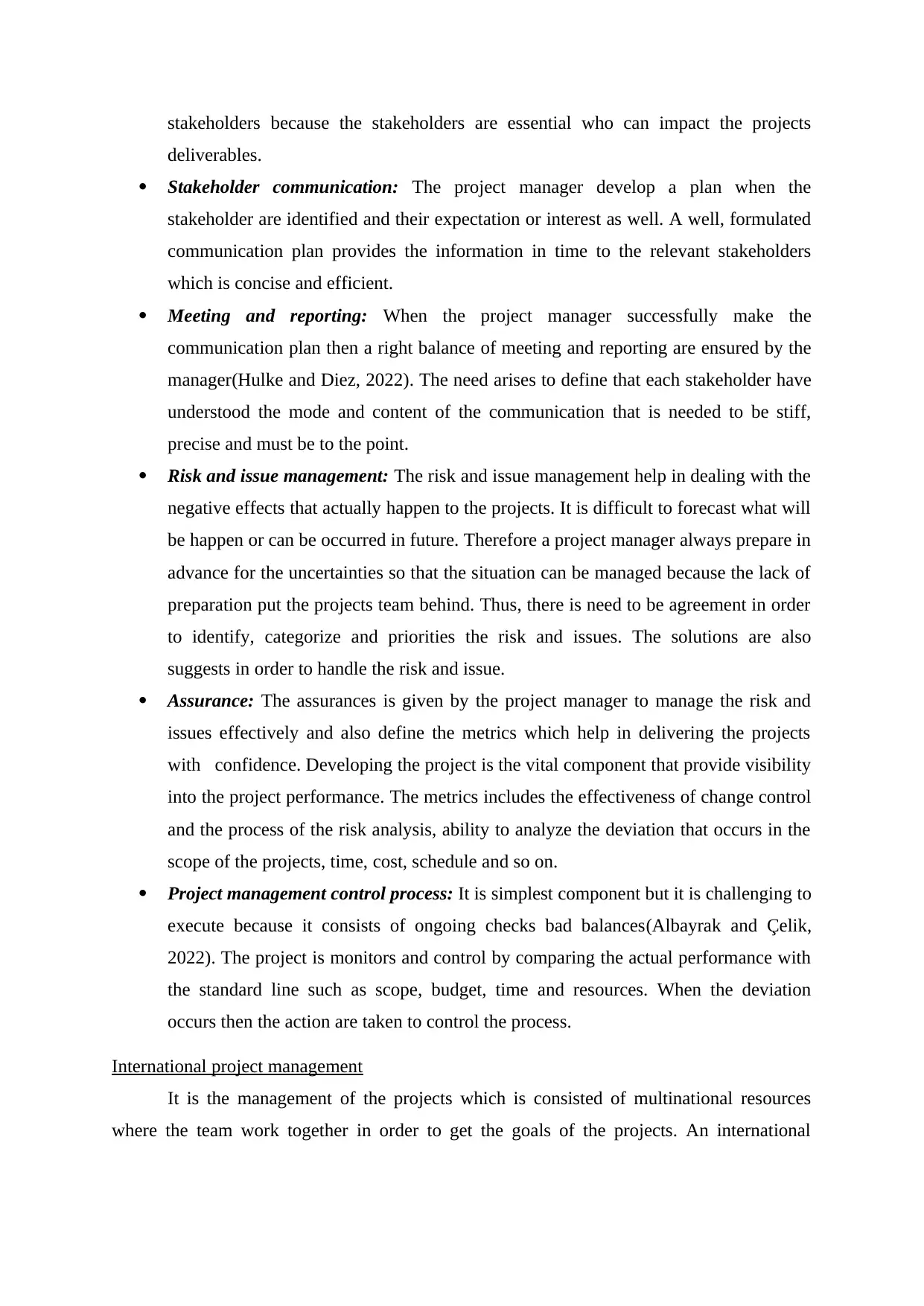
stakeholders because the stakeholders are essential who can impact the projects
deliverables.
Stakeholder communication: The project manager develop a plan when the
stakeholder are identified and their expectation or interest as well. A well, formulated
communication plan provides the information in time to the relevant stakeholders
which is concise and efficient.
Meeting and reporting: When the project manager successfully make the
communication plan then a right balance of meeting and reporting are ensured by the
manager(Hulke and Diez, 2022). The need arises to define that each stakeholder have
understood the mode and content of the communication that is needed to be stiff,
precise and must be to the point.
Risk and issue management: The risk and issue management help in dealing with the
negative effects that actually happen to the projects. It is difficult to forecast what will
be happen or can be occurred in future. Therefore a project manager always prepare in
advance for the uncertainties so that the situation can be managed because the lack of
preparation put the projects team behind. Thus, there is need to be agreement in order
to identify, categorize and priorities the risk and issues. The solutions are also
suggests in order to handle the risk and issue.
Assurance: The assurances is given by the project manager to manage the risk and
issues effectively and also define the metrics which help in delivering the projects
with confidence. Developing the project is the vital component that provide visibility
into the project performance. The metrics includes the effectiveness of change control
and the process of the risk analysis, ability to analyze the deviation that occurs in the
scope of the projects, time, cost, schedule and so on.
Project management control process: It is simplest component but it is challenging to
execute because it consists of ongoing checks bad balances(Albayrak and Çelik,
2022). The project is monitors and control by comparing the actual performance with
the standard line such as scope, budget, time and resources. When the deviation
occurs then the action are taken to control the process.
International project management
It is the management of the projects which is consisted of multinational resources
where the team work together in order to get the goals of the projects. An international
deliverables.
Stakeholder communication: The project manager develop a plan when the
stakeholder are identified and their expectation or interest as well. A well, formulated
communication plan provides the information in time to the relevant stakeholders
which is concise and efficient.
Meeting and reporting: When the project manager successfully make the
communication plan then a right balance of meeting and reporting are ensured by the
manager(Hulke and Diez, 2022). The need arises to define that each stakeholder have
understood the mode and content of the communication that is needed to be stiff,
precise and must be to the point.
Risk and issue management: The risk and issue management help in dealing with the
negative effects that actually happen to the projects. It is difficult to forecast what will
be happen or can be occurred in future. Therefore a project manager always prepare in
advance for the uncertainties so that the situation can be managed because the lack of
preparation put the projects team behind. Thus, there is need to be agreement in order
to identify, categorize and priorities the risk and issues. The solutions are also
suggests in order to handle the risk and issue.
Assurance: The assurances is given by the project manager to manage the risk and
issues effectively and also define the metrics which help in delivering the projects
with confidence. Developing the project is the vital component that provide visibility
into the project performance. The metrics includes the effectiveness of change control
and the process of the risk analysis, ability to analyze the deviation that occurs in the
scope of the projects, time, cost, schedule and so on.
Project management control process: It is simplest component but it is challenging to
execute because it consists of ongoing checks bad balances(Albayrak and Çelik,
2022). The project is monitors and control by comparing the actual performance with
the standard line such as scope, budget, time and resources. When the deviation
occurs then the action are taken to control the process.
International project management
It is the management of the projects which is consisted of multinational resources
where the team work together in order to get the goals of the projects. An international
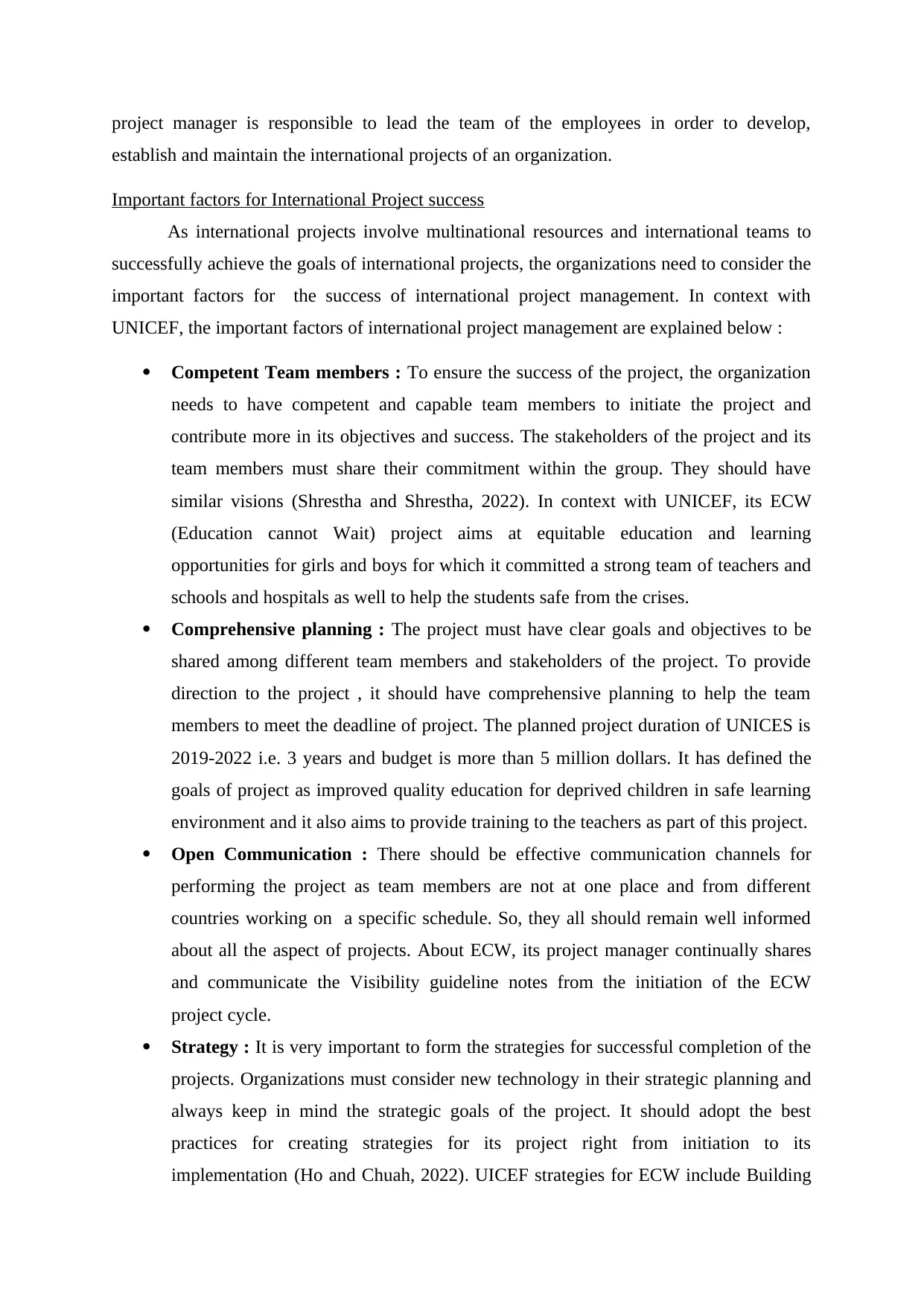
project manager is responsible to lead the team of the employees in order to develop,
establish and maintain the international projects of an organization.
Important factors for International Project success
As international projects involve multinational resources and international teams to
successfully achieve the goals of international projects, the organizations need to consider the
important factors for the success of international project management. In context with
UNICEF, the important factors of international project management are explained below :
Competent Team members : To ensure the success of the project, the organization
needs to have competent and capable team members to initiate the project and
contribute more in its objectives and success. The stakeholders of the project and its
team members must share their commitment within the group. They should have
similar visions (Shrestha and Shrestha, 2022). In context with UNICEF, its ECW
(Education cannot Wait) project aims at equitable education and learning
opportunities for girls and boys for which it committed a strong team of teachers and
schools and hospitals as well to help the students safe from the crises.
Comprehensive planning : The project must have clear goals and objectives to be
shared among different team members and stakeholders of the project. To provide
direction to the project , it should have comprehensive planning to help the team
members to meet the deadline of project. The planned project duration of UNICES is
2019-2022 i.e. 3 years and budget is more than 5 million dollars. It has defined the
goals of project as improved quality education for deprived children in safe learning
environment and it also aims to provide training to the teachers as part of this project.
Open Communication : There should be effective communication channels for
performing the project as team members are not at one place and from different
countries working on a specific schedule. So, they all should remain well informed
about all the aspect of projects. About ECW, its project manager continually shares
and communicate the Visibility guideline notes from the initiation of the ECW
project cycle.
Strategy : It is very important to form the strategies for successful completion of the
projects. Organizations must consider new technology in their strategic planning and
always keep in mind the strategic goals of the project. It should adopt the best
practices for creating strategies for its project right from initiation to its
implementation (Ho and Chuah, 2022). UICEF strategies for ECW include Building
establish and maintain the international projects of an organization.
Important factors for International Project success
As international projects involve multinational resources and international teams to
successfully achieve the goals of international projects, the organizations need to consider the
important factors for the success of international project management. In context with
UNICEF, the important factors of international project management are explained below :
Competent Team members : To ensure the success of the project, the organization
needs to have competent and capable team members to initiate the project and
contribute more in its objectives and success. The stakeholders of the project and its
team members must share their commitment within the group. They should have
similar visions (Shrestha and Shrestha, 2022). In context with UNICEF, its ECW
(Education cannot Wait) project aims at equitable education and learning
opportunities for girls and boys for which it committed a strong team of teachers and
schools and hospitals as well to help the students safe from the crises.
Comprehensive planning : The project must have clear goals and objectives to be
shared among different team members and stakeholders of the project. To provide
direction to the project , it should have comprehensive planning to help the team
members to meet the deadline of project. The planned project duration of UNICES is
2019-2022 i.e. 3 years and budget is more than 5 million dollars. It has defined the
goals of project as improved quality education for deprived children in safe learning
environment and it also aims to provide training to the teachers as part of this project.
Open Communication : There should be effective communication channels for
performing the project as team members are not at one place and from different
countries working on a specific schedule. So, they all should remain well informed
about all the aspect of projects. About ECW, its project manager continually shares
and communicate the Visibility guideline notes from the initiation of the ECW
project cycle.
Strategy : It is very important to form the strategies for successful completion of the
projects. Organizations must consider new technology in their strategic planning and
always keep in mind the strategic goals of the project. It should adopt the best
practices for creating strategies for its project right from initiation to its
implementation (Ho and Chuah, 2022). UICEF strategies for ECW include Building
⊘ This is a preview!⊘
Do you want full access?
Subscribe today to unlock all pages.

Trusted by 1+ million students worldwide
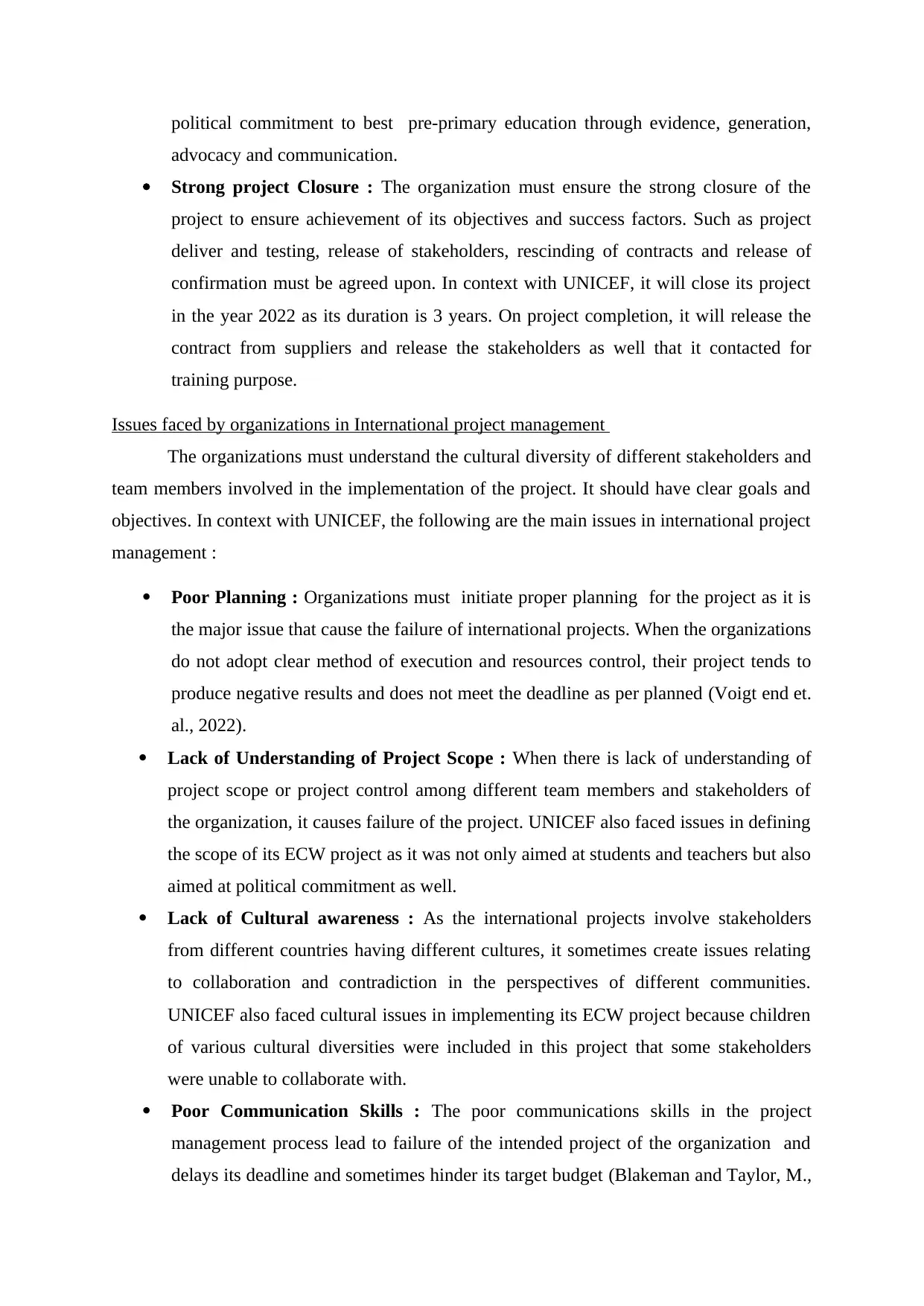
political commitment to best pre-primary education through evidence, generation,
advocacy and communication.
Strong project Closure : The organization must ensure the strong closure of the
project to ensure achievement of its objectives and success factors. Such as project
deliver and testing, release of stakeholders, rescinding of contracts and release of
confirmation must be agreed upon. In context with UNICEF, it will close its project
in the year 2022 as its duration is 3 years. On project completion, it will release the
contract from suppliers and release the stakeholders as well that it contacted for
training purpose.
Issues faced by organizations in International project management
The organizations must understand the cultural diversity of different stakeholders and
team members involved in the implementation of the project. It should have clear goals and
objectives. In context with UNICEF, the following are the main issues in international project
management :
Poor Planning : Organizations must initiate proper planning for the project as it is
the major issue that cause the failure of international projects. When the organizations
do not adopt clear method of execution and resources control, their project tends to
produce negative results and does not meet the deadline as per planned (Voigt end et.
al., 2022).
Lack of Understanding of Project Scope : When there is lack of understanding of
project scope or project control among different team members and stakeholders of
the organization, it causes failure of the project. UNICEF also faced issues in defining
the scope of its ECW project as it was not only aimed at students and teachers but also
aimed at political commitment as well.
Lack of Cultural awareness : As the international projects involve stakeholders
from different countries having different cultures, it sometimes create issues relating
to collaboration and contradiction in the perspectives of different communities.
UNICEF also faced cultural issues in implementing its ECW project because children
of various cultural diversities were included in this project that some stakeholders
were unable to collaborate with.
Poor Communication Skills : The poor communications skills in the project
management process lead to failure of the intended project of the organization and
delays its deadline and sometimes hinder its target budget (Blakeman and Taylor, M.,
advocacy and communication.
Strong project Closure : The organization must ensure the strong closure of the
project to ensure achievement of its objectives and success factors. Such as project
deliver and testing, release of stakeholders, rescinding of contracts and release of
confirmation must be agreed upon. In context with UNICEF, it will close its project
in the year 2022 as its duration is 3 years. On project completion, it will release the
contract from suppliers and release the stakeholders as well that it contacted for
training purpose.
Issues faced by organizations in International project management
The organizations must understand the cultural diversity of different stakeholders and
team members involved in the implementation of the project. It should have clear goals and
objectives. In context with UNICEF, the following are the main issues in international project
management :
Poor Planning : Organizations must initiate proper planning for the project as it is
the major issue that cause the failure of international projects. When the organizations
do not adopt clear method of execution and resources control, their project tends to
produce negative results and does not meet the deadline as per planned (Voigt end et.
al., 2022).
Lack of Understanding of Project Scope : When there is lack of understanding of
project scope or project control among different team members and stakeholders of
the organization, it causes failure of the project. UNICEF also faced issues in defining
the scope of its ECW project as it was not only aimed at students and teachers but also
aimed at political commitment as well.
Lack of Cultural awareness : As the international projects involve stakeholders
from different countries having different cultures, it sometimes create issues relating
to collaboration and contradiction in the perspectives of different communities.
UNICEF also faced cultural issues in implementing its ECW project because children
of various cultural diversities were included in this project that some stakeholders
were unable to collaborate with.
Poor Communication Skills : The poor communications skills in the project
management process lead to failure of the intended project of the organization and
delays its deadline and sometimes hinder its target budget (Blakeman and Taylor, M.,
Paraphrase This Document
Need a fresh take? Get an instant paraphrase of this document with our AI Paraphraser
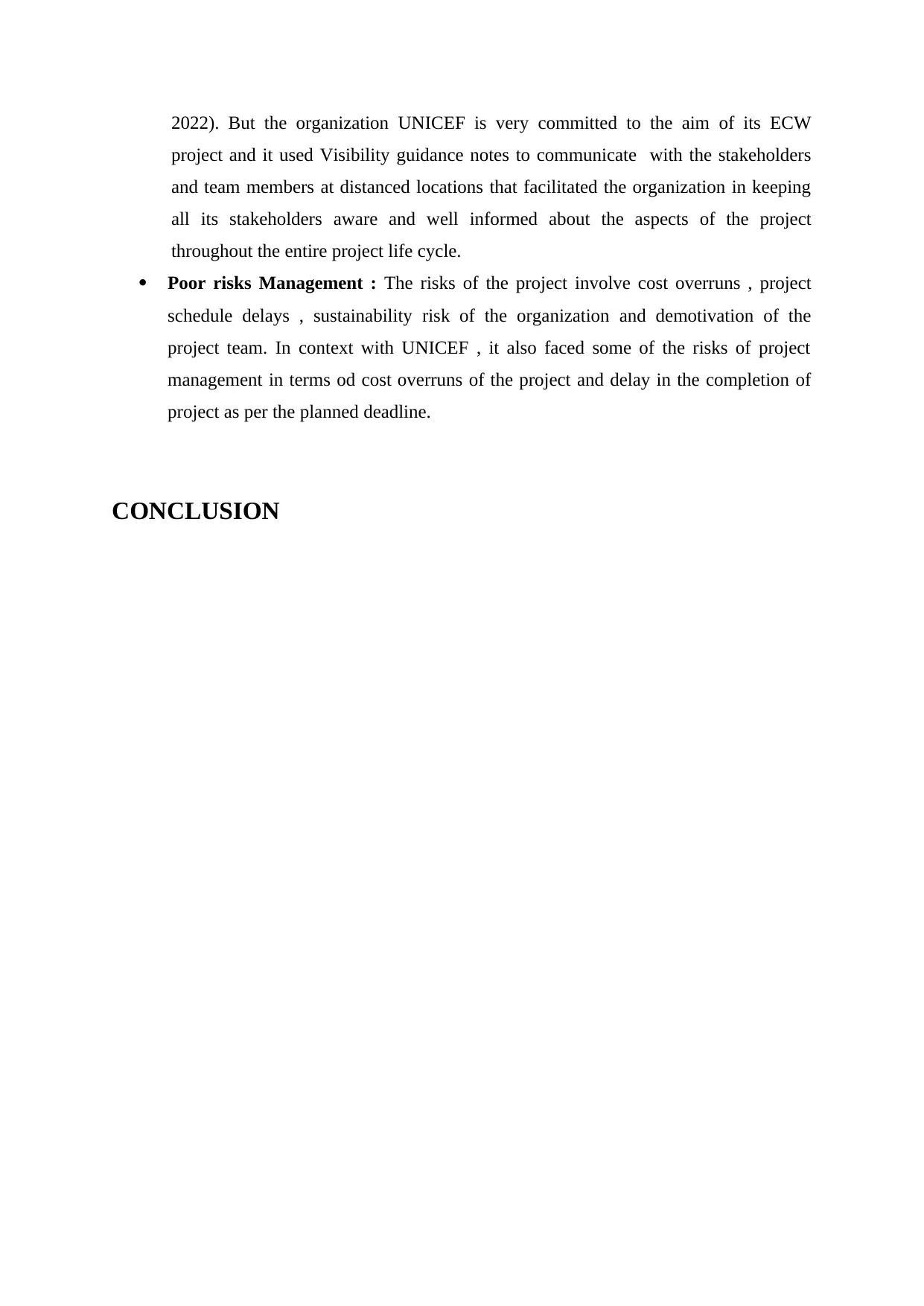
2022). But the organization UNICEF is very committed to the aim of its ECW
project and it used Visibility guidance notes to communicate with the stakeholders
and team members at distanced locations that facilitated the organization in keeping
all its stakeholders aware and well informed about the aspects of the project
throughout the entire project life cycle.
Poor risks Management : The risks of the project involve cost overruns , project
schedule delays , sustainability risk of the organization and demotivation of the
project team. In context with UNICEF , it also faced some of the risks of project
management in terms od cost overruns of the project and delay in the completion of
project as per the planned deadline.
CONCLUSION
project and it used Visibility guidance notes to communicate with the stakeholders
and team members at distanced locations that facilitated the organization in keeping
all its stakeholders aware and well informed about the aspects of the project
throughout the entire project life cycle.
Poor risks Management : The risks of the project involve cost overruns , project
schedule delays , sustainability risk of the organization and demotivation of the
project team. In context with UNICEF , it also faced some of the risks of project
management in terms od cost overruns of the project and delay in the completion of
project as per the planned deadline.
CONCLUSION
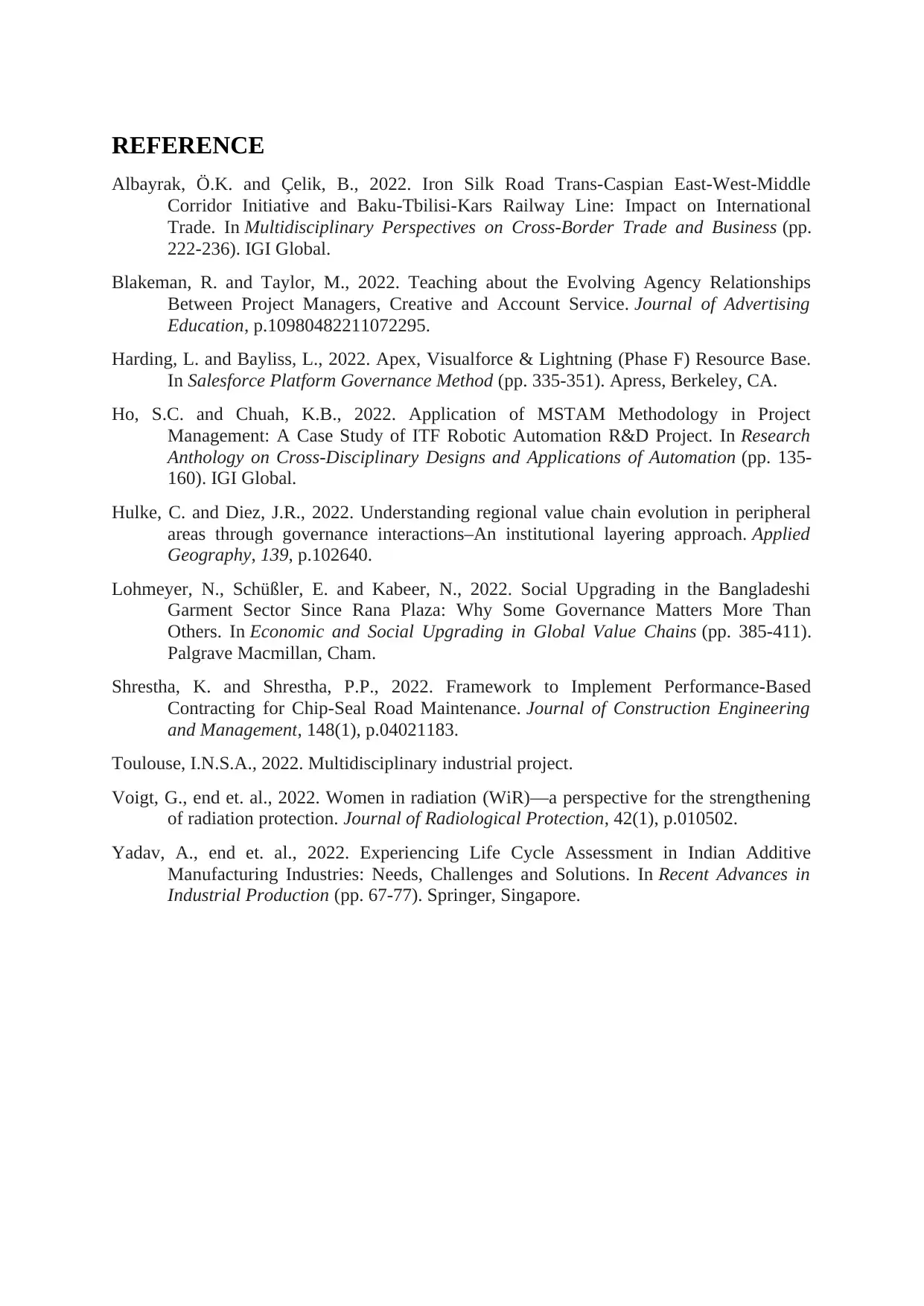
REFERENCE
Albayrak, Ö.K. and Çelik, B., 2022. Iron Silk Road Trans-Caspian East-West-Middle
Corridor Initiative and Baku-Tbilisi-Kars Railway Line: Impact on International
Trade. In Multidisciplinary Perspectives on Cross-Border Trade and Business (pp.
222-236). IGI Global.
Blakeman, R. and Taylor, M., 2022. Teaching about the Evolving Agency Relationships
Between Project Managers, Creative and Account Service. Journal of Advertising
Education, p.10980482211072295.
Harding, L. and Bayliss, L., 2022. Apex, Visualforce & Lightning (Phase F) Resource Base.
In Salesforce Platform Governance Method (pp. 335-351). Apress, Berkeley, CA.
Ho, S.C. and Chuah, K.B., 2022. Application of MSTAM Methodology in Project
Management: A Case Study of ITF Robotic Automation R&D Project. In Research
Anthology on Cross-Disciplinary Designs and Applications of Automation (pp. 135-
160). IGI Global.
Hulke, C. and Diez, J.R., 2022. Understanding regional value chain evolution in peripheral
areas through governance interactions–An institutional layering approach. Applied
Geography, 139, p.102640.
Lohmeyer, N., Schüßler, E. and Kabeer, N., 2022. Social Upgrading in the Bangladeshi
Garment Sector Since Rana Plaza: Why Some Governance Matters More Than
Others. In Economic and Social Upgrading in Global Value Chains (pp. 385-411).
Palgrave Macmillan, Cham.
Shrestha, K. and Shrestha, P.P., 2022. Framework to Implement Performance-Based
Contracting for Chip-Seal Road Maintenance. Journal of Construction Engineering
and Management, 148(1), p.04021183.
Toulouse, I.N.S.A., 2022. Multidisciplinary industrial project.
Voigt, G., end et. al., 2022. Women in radiation (WiR)—a perspective for the strengthening
of radiation protection. Journal of Radiological Protection, 42(1), p.010502.
Yadav, A., end et. al., 2022. Experiencing Life Cycle Assessment in Indian Additive
Manufacturing Industries: Needs, Challenges and Solutions. In Recent Advances in
Industrial Production (pp. 67-77). Springer, Singapore.
Albayrak, Ö.K. and Çelik, B., 2022. Iron Silk Road Trans-Caspian East-West-Middle
Corridor Initiative and Baku-Tbilisi-Kars Railway Line: Impact on International
Trade. In Multidisciplinary Perspectives on Cross-Border Trade and Business (pp.
222-236). IGI Global.
Blakeman, R. and Taylor, M., 2022. Teaching about the Evolving Agency Relationships
Between Project Managers, Creative and Account Service. Journal of Advertising
Education, p.10980482211072295.
Harding, L. and Bayliss, L., 2022. Apex, Visualforce & Lightning (Phase F) Resource Base.
In Salesforce Platform Governance Method (pp. 335-351). Apress, Berkeley, CA.
Ho, S.C. and Chuah, K.B., 2022. Application of MSTAM Methodology in Project
Management: A Case Study of ITF Robotic Automation R&D Project. In Research
Anthology on Cross-Disciplinary Designs and Applications of Automation (pp. 135-
160). IGI Global.
Hulke, C. and Diez, J.R., 2022. Understanding regional value chain evolution in peripheral
areas through governance interactions–An institutional layering approach. Applied
Geography, 139, p.102640.
Lohmeyer, N., Schüßler, E. and Kabeer, N., 2022. Social Upgrading in the Bangladeshi
Garment Sector Since Rana Plaza: Why Some Governance Matters More Than
Others. In Economic and Social Upgrading in Global Value Chains (pp. 385-411).
Palgrave Macmillan, Cham.
Shrestha, K. and Shrestha, P.P., 2022. Framework to Implement Performance-Based
Contracting for Chip-Seal Road Maintenance. Journal of Construction Engineering
and Management, 148(1), p.04021183.
Toulouse, I.N.S.A., 2022. Multidisciplinary industrial project.
Voigt, G., end et. al., 2022. Women in radiation (WiR)—a perspective for the strengthening
of radiation protection. Journal of Radiological Protection, 42(1), p.010502.
Yadav, A., end et. al., 2022. Experiencing Life Cycle Assessment in Indian Additive
Manufacturing Industries: Needs, Challenges and Solutions. In Recent Advances in
Industrial Production (pp. 67-77). Springer, Singapore.
⊘ This is a preview!⊘
Do you want full access?
Subscribe today to unlock all pages.

Trusted by 1+ million students worldwide

Paraphrase This Document
Need a fresh take? Get an instant paraphrase of this document with our AI Paraphraser

1 out of 11
Related Documents
Your All-in-One AI-Powered Toolkit for Academic Success.
+13062052269
info@desklib.com
Available 24*7 on WhatsApp / Email
![[object Object]](/_next/static/media/star-bottom.7253800d.svg)
Unlock your academic potential
Copyright © 2020–2025 A2Z Services. All Rights Reserved. Developed and managed by ZUCOL.



